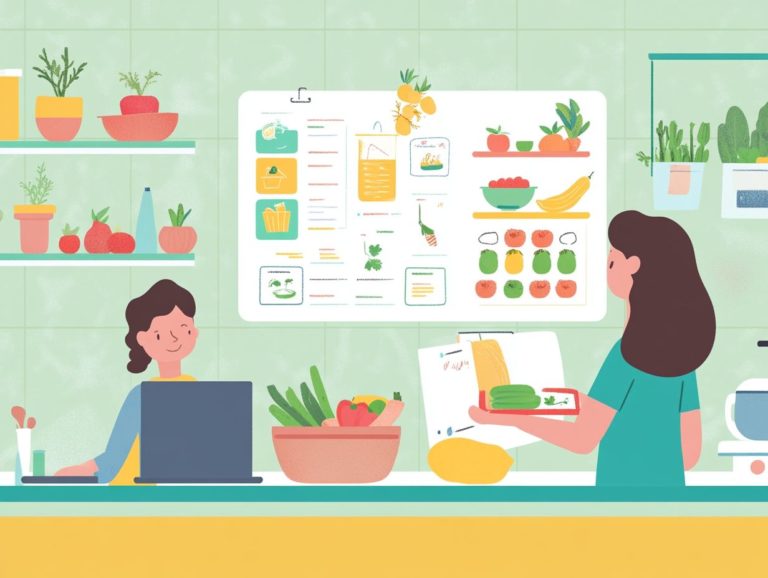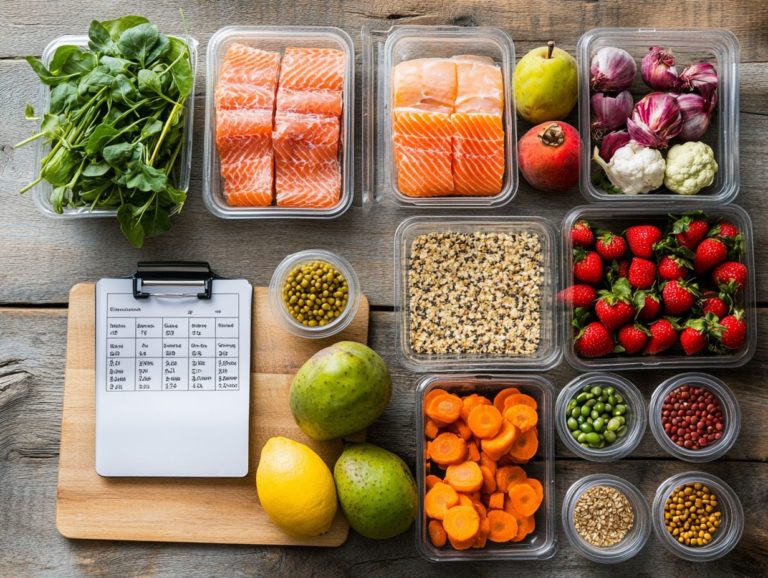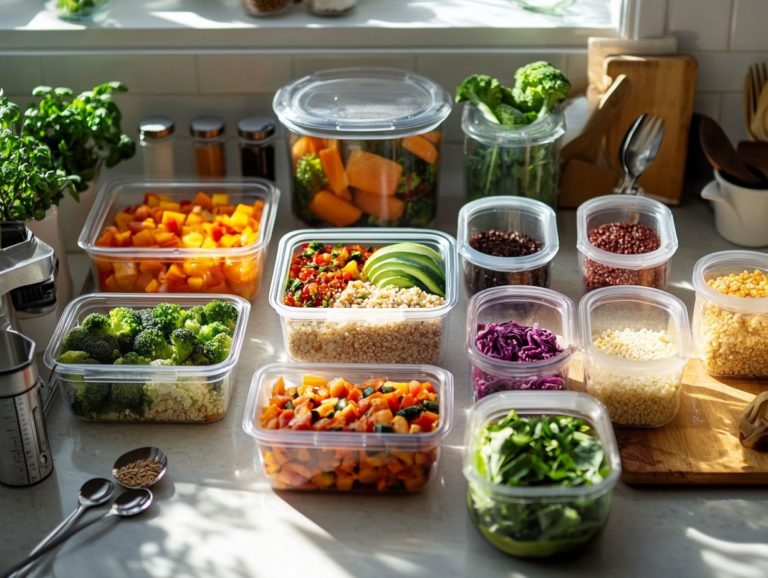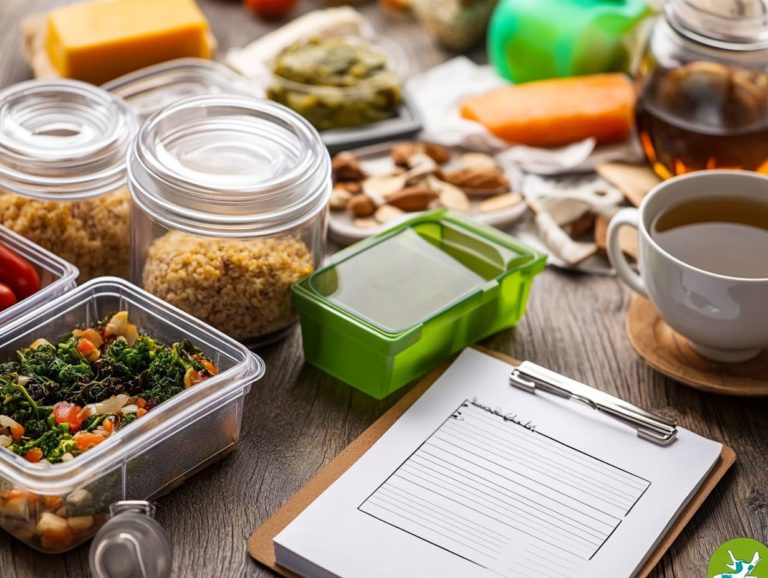How to Plan Meals for Weight Loss
Meal planning can change your eating habits for the better! By establishing a structured plan, you save time and money while making mindful food choices. This article explores the many benefits of meal planning and offers tips for creating your personalized meal plan, including insights into portion control and foods rich in nutrients.
You ll also discover effective meal prep strategies and motivation techniques to keep you on track. Start meal planning today to see amazing results!
Contents
- Key Takeaways:
- Creating a Meal Plan
- Healthy Eating Habits for Weight Loss
- Meal Prep Tips for Success
- Staying Motivated and On Track
- Frequently Asked Questions
- What are some tips for planning meals for weight loss?
- How can I make meal planning easier for weight loss?
- Can I still enjoy my favorite foods while planning meals for weight loss?
- What are some common mistakes to avoid when planning meals for weight loss?
- How can I stick to my meal plan for weight loss when eating out?
- Is it necessary to count calories when planning meals for weight loss?
Key Takeaways:
- Plan your meals in advance to save time and stay on track with healthy eating for weight loss.
- Focus on portion control and include foods rich in nutrients in your meal plan for successful weight loss.
- Incorporate time-saving strategies and proper storage techniques for meal prep success and stay motivated during setbacks.
Benefits of Meal Planning
Meal planning simplifies grocery shopping and helps you reach your weight loss goals by ensuring you consume meals rich in nutrients that meet your dietary needs. By learning how to use a meal planner effectively, you can maintain a calorie deficit, which means consuming fewer calories than you burn, while enjoying a variety of foods that promote healthy eating habits and sustainable weight loss.
With structured meal prep, you can efficiently prepare nutritious meals, reducing the temptation to reach for processed foods and unhealthy snacks.
By planning your weekly meals, you ll make informed choices that prioritize fresh fruits, vegetables, whole grains, and lean proteins foods packed with essential nutrients. This organized approach streamlines your shopping experience with a well-structured grocery list, allowing you to save money by buying in larger quantities and choosing seasonal options.
Meal planning helps you manage portion sizes, ensuring your servings are both appropriate and satisfying, contributing to your overall health. For instance, having pre-portioned containers of quinoa, roasted vegetables, and grilled chicken ready for the week makes healthier decisions effortless and alleviates last-minute cooking stress.
Creating a Meal Plan
Creating a meal plan requires a thoughtful approach tailored to your unique dietary needs and preferences. Start by evaluating your weight loss goals and reflecting on your cooking skills and dietary restrictions. For effective strategies, consider meal planning for weight maintenance. This evaluation will help you develop a sustainable meal planning strategy.
Shopping with a personalized grocery list not only streamlines the process but also ensures you have all the essential ingredients for nutritious meals that truly satisfy your palate.
Factors to Consider
When planning your meals, several critical factors can help you successfully reach your weight loss goals:
- Assess your dietary needs, restrictions, and preferences to find the best meal options.
- Evaluate cooking time and choose appropriate recipes to make your meal prep day efficient and enjoyable.
- Understand portion sizes, as they directly affect your caloric intake and nutritional balance.
- Consider your cooking skills if you re experienced, explore intricate recipes; if you’re a beginner, stick to simple, quick options.
- Address time constraints by opting for versatile ingredients that can be prepped in bulk.
- Include a variety of proteins, carbs, and healthy fats in your meals to meet your nutrient requirements.
By organizing a weekly schedule that considers your busy days, you’ll find it easier to stick to your meal plan while enjoying a diverse and satisfying diet.
Ready to take control of your meals? Start planning today!
Sample Meal Plan
A structured sample meal plan can be an invaluable tool for anyone aiming to achieve weight loss through strategic meal preparation. This plan should include a variety of foods, such as whole grains, lean proteins, fruits, and vegetables. For those following dietary restrictions, learning how to plan meals for a gluten-free diet is also essential. It’s important to incorporate healthy snacks to maintain your energy levels throughout the day and pay attention to portion sizes to monitor calorie intake, ensuring a calorie deficit for effective weight loss.
By prioritizing meals that are high in nutrients, you can support your overall health while shedding unwanted pounds. For example, a balanced breakfast like oatmeal topped with berries offers fiber and antioxidants, setting a positive tone for your day!
For lunch, consider a quinoa salad brimming with mixed greens and grilled chicken. This combination provides satisfaction and essential nutrients. Dinners can range from grilled salmon paired with steamed broccoli to a vibrant veggie stir-fry with brown rice, catering to diverse dietary preferences.
Snacks such as hummus with carrot sticks or Greek yogurt topped with nuts can help maintain balanced energy levels, staving off cravings and keeping you focused on your dietary goals. Enjoy your delicious meals while watching the pounds melt away!
Healthy Eating Habits for Weight Loss

Adopting healthy eating habits is essential for achieving effective weight loss and enhancing overall wellness.
Focus on key practices like portion control, which helps manage your calorie intake. Incorporating a diverse array of nutrient-rich foods like vibrant fruits, fresh vegetables, and healthy fats into your daily meals is vital.
By prioritizing protein-rich foods and minimizing processed options, you can create a balanced approach that promotes lasting weight loss while nurturing your well-being.
Portion Control
Portion control is crucial for your journey toward a healthy meal plan and sustainable weight loss. Being mindful of portion sizes helps you manage your calorie intake effectively, which is essential for shedding those extra pounds.
To enhance your portion control, employ practical strategies. One effective approach is to use measuring cups or a kitchen scale to accurately gauge serving sizes. This ensures you consume just the right amount of food without overshooting your calorie goals.
Visual cues can also be your allies. Imagine a plate filled proportionately with vibrant vegetables, lean proteins, and wholesome carbohydrates to help guide your choices. Using smaller plates can trick your mind into feeling satisfied with less food.
As portion sizes have increased over the years, being aware of these strategies can positively impact your overall health not just in weight management, but also in cultivating healthier eating habits for the long run.
Incorporating Nutrient-Dense Foods
Incorporating nutrient-dense foods into your diet is crucial for enhancing your health while striving toward your weight loss goals. By focusing on fruits and vegetables, healthy fats, and whole grains, you can design a balanced and satisfying meal plan rich in delicious recipes that nourish your body.
For example, whip up a hearty quinoa salad featuring a vibrant blend of kale, cherry tomatoes, and avocado. Drizzle it with a zesty lemon dressing for a refreshing nutrient boost!
Using cooking techniques like steaming vegetables or baking lean proteins helps preserve their nutrient profiles, ensuring you reap maximum health benefits.
As for snacks, consider hummus paired with crisp carrot sticks or a handful of mixed nuts. These options will keep your energy levels steady while supporting your weight loss journey.
By embracing these nutritious choices, you not only nurture your overall wellness but also keep your meals enjoyable and satisfying. Start your transformation today!
Meal Prep Tips for Success
Effective meal prep serves as the foundation of successful weight loss. It equips you with the tools and resources to effortlessly make healthier food choices. By implementing time-saving strategies like batch cooking, you can streamline your meal prep day and guarantee that nutritious meals are readily available throughout the week.
Using the right food storage containers enhances your organization and extends the longevity of your prepared meals. This ensures that your cooking remains fresh and appealing.
Time-Saving Strategies
Time-saving strategies are crucial for making your meal prep both efficient and enjoyable. Designate a specific day for batch cooking and craft a well-organized grocery list. This way, you ll dramatically cut down on cooking time during the week.
This approach ensures you always have healthy recipe ideas at your fingertips, perfectly aligned with your dietary goals. Incorporating techniques like pre-chopping vegetables streamlines your cooking process, allowing you to grab ingredients in a flash.
Utilizing slow cookers can also work wonders. They transform your meals with minimal effort, allowing for hands-off cooking, freeing you to focus on other tasks. Choose quick-cooking grains such as quinoa or bulgur to save time while enhancing your nutrition.
Taking advantage of online grocery shopping elevates your efficiency. You gain easy access to fresh produce and healthy pantry staples without the hassle of wandering through the aisles.
Storage and Reheating Techniques
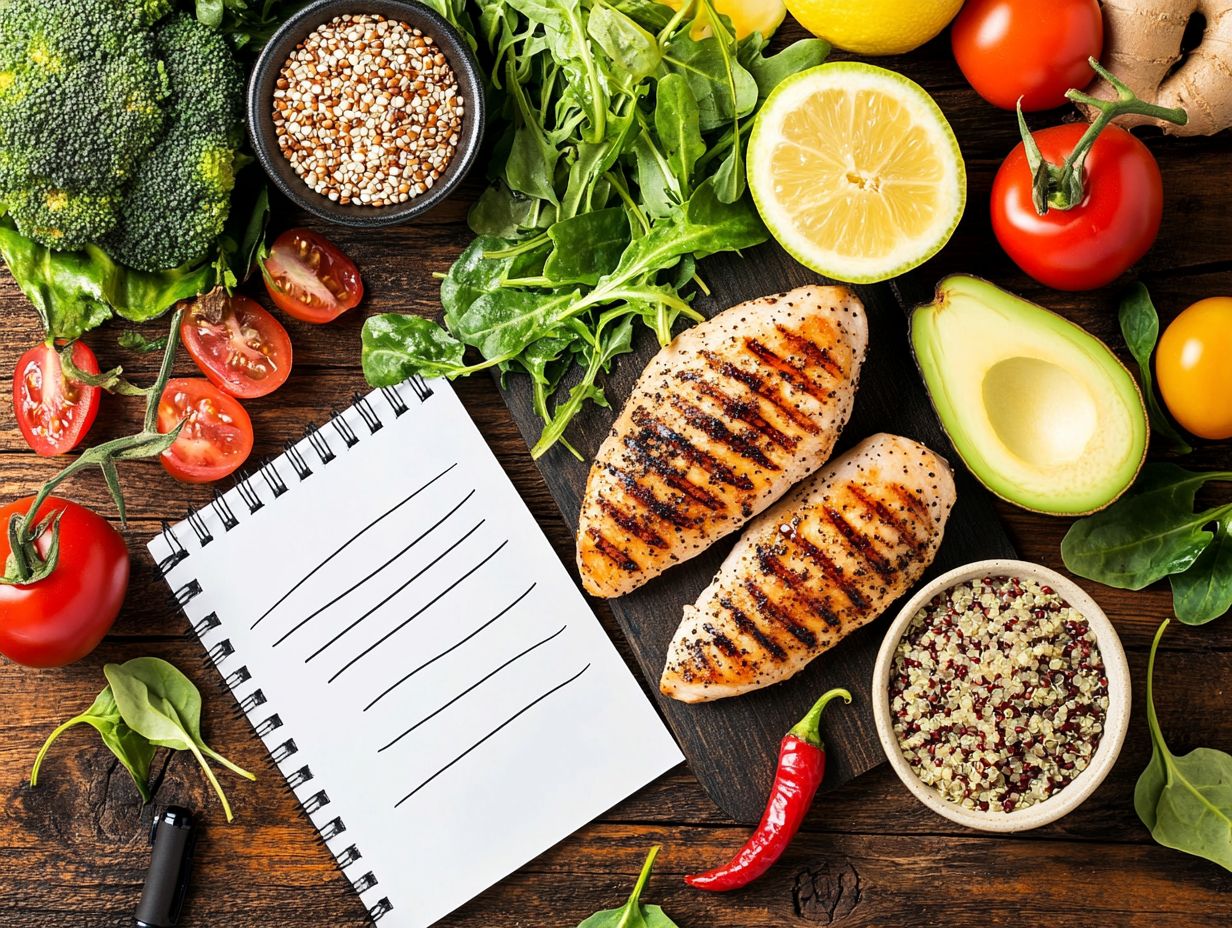
Proper storage and reheating techniques are essential elements of meal prep. They enhance food safety and preserve the quality of your meals. By using appropriate food storage containers, you can keep the freshness and nutritional value of your dishes intact.
Mastering reheating techniques ensures that your meals remain safe and delicious to consume. Stick to recommended temperature guidelines like keeping your refrigerator below 40 F and storing hot foods at 140 F or higher to significantly reduce the risk of foodborne illnesses.
Opt for airtight containers made of glass or BPA-free plastic. They keep your meals fresher for longer and prevent cross-contamination. Thoughtfully organizing your fridge and pantry placing older items in front for easy access helps you minimize waste.
When it s time to reheat, consider methods like steaming or microwaving with a cover. These methods revitalize the flavor and texture of leftovers, turning mealtime into a more enjoyable experience.
Staying Motivated and On Track
Staying motivated on your weight loss journey can indeed pose its challenges. Establishing realistic goals and implementing effective meal planning strategies can furnish the essential structure for your success.
It’s crucial to acknowledge that setbacks are an inherent aspect of any journey. Understanding how to navigate these obstacles allows you to maintain your focus and continue progressing toward your health goals.
Setting Realistic Goals
Setting realistic goals is essential for your weight management success, especially regarding meal planning and achieving sustainable weight loss. Define achievable weight loss targets to craft a meal planning strategy that fits seamlessly into your lifestyle.
Instead of chasing the unrealistic dream of losing 20 pounds in a month, focus on a more manageable goal of 1 to 2 pounds per week. This approach simplifies your eating habits and minimizes overwhelming feelings that often come with drastic changes.
Incremental goals, like boosting your daily activity levels or incorporating more vegetables into each meal, are crucial for maintaining motivation. Celebrate these small victories to find yourself more committed to your weight loss journey.
Create a positive feedback loop that encourages persistence and keeps you aligned with your broader health objectives. Start your meal prep today and feel the difference!
Dealing with Setbacks
Dealing with setbacks is an inevitable aspect of your weight loss journey. However, how you respond can significantly influence your overall success. Acknowledging that setbacks may arise in your meal planning or healthy eating allows you to build a strong mindset, keeping you motivated and focused.
Rather than letting a temporary hiccup derail your progress, turn those setbacks into stepping stones for success! Seek support from friends, family, or even online communities for encouragement and accountability.
Reassessing your goals provides a constructive perspective, ensuring they remain realistic and attainable. Understanding that obstacles are simply part of the process helps maintain continuity in your healthy habits.
Whether it involves adjusting your meal prep or discovering enjoyable physical activities, embracing flexibility can pave the way for long-term success.
Frequently Asked Questions
What are some tips for planning meals for weight loss?
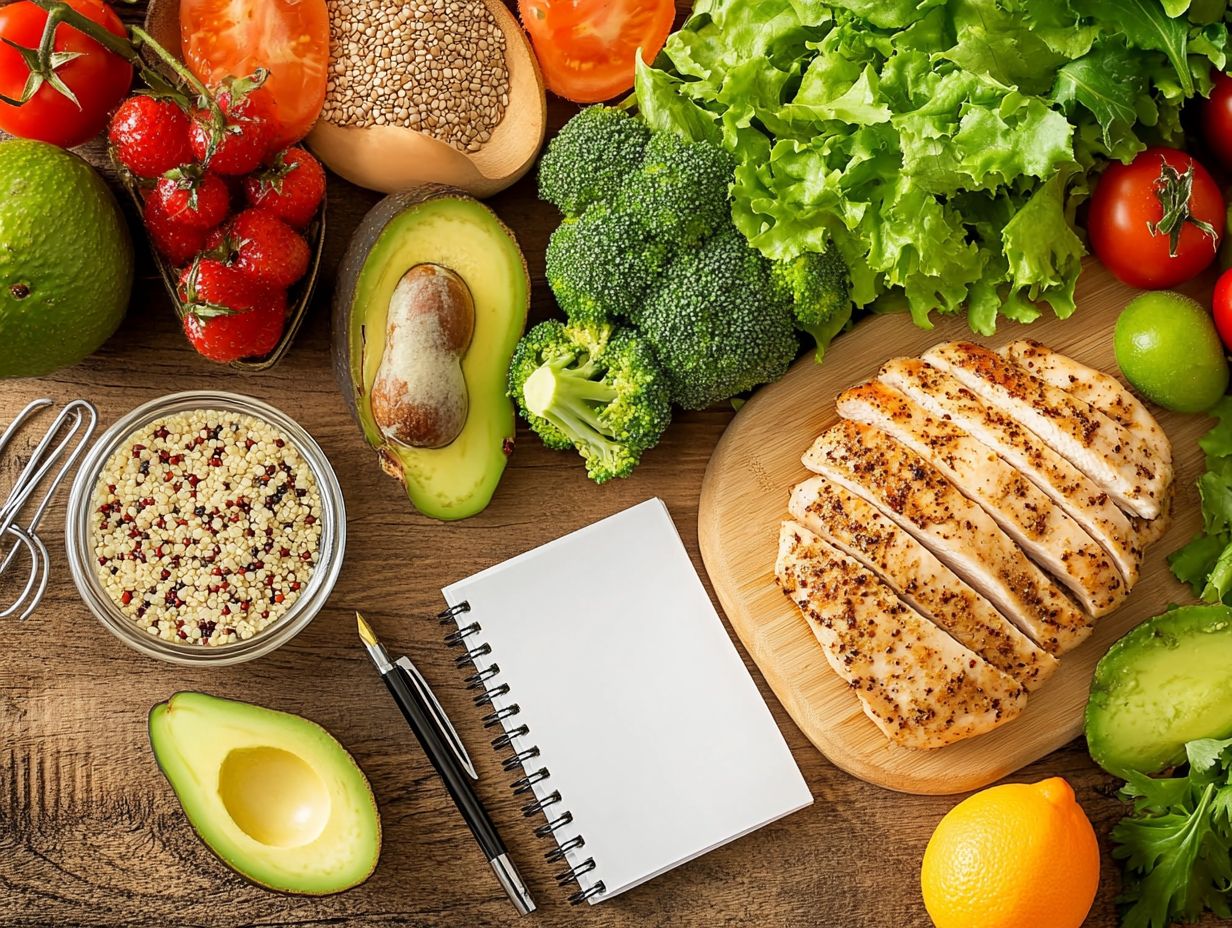
1. Start by creating a meal plan for the week, including all meals and snacks.
2. Incorporate a variety of fruits, vegetables, lean proteins, and whole grains into each meal.
3. Plan for smaller portion sizes and limit high-calorie and high-fat foods.
4. Have healthy snacks on hand to prevent overeating.
5. Always read nutrition labels and choose foods with lower calorie and fat content.
6. Stay hydrated by drinking plenty of water throughout the day.
How can I make meal planning easier for weight loss?
1. Utilize meal planning apps or websites to help plan and track your meals.
2. Prepare meals and snacks in advance to save time and prevent unhealthy food choices.
3. Look for healthy, easy-to-make recipes to incorporate into your meal plan.
4. Swap out unhealthy ingredients for healthier alternatives, such as using Greek yogurt instead of sour cream.
5. Keep a well-stocked pantry with healthy staples for convenient meal preparation.
6. Consider meal prepping for the entire week to save time and stay on track with your weight loss goals.
Can I still enjoy my favorite foods while planning meals for weight loss?
1. Yes, you can still enjoy your favorite foods in moderation while planning meals for weight loss.
2. Allow yourself to have small portions of your favorite foods occasionally to prevent feelings of deprivation.
3. Find healthier versions of your favorite meals, like using zucchini noodles instead of pasta.
4. Balance your meal plan by incorporating healthy foods and treats in moderation.
5. Listen to your body and stop eating when you feel satisfied, not completely full.
What are some common mistakes to avoid when planning meals for weight loss?
1. Skipping meals or drastically cutting calories can hinder weight loss progress.
2. Relying on processed diet foods or meal replacement products is not sustainable long term.
3. Not incorporating enough protein and fiber can lead to overeating and dissatisfaction.
4. Neglecting to plan for healthy snacks can result in unhealthy food choices when hunger strikes.
5. Avoiding all carbs is unnecessary for weight loss; it’s important to choose healthy carbohydrates in moderation.
6. Don’t forget to include healthy fats in your meals, as they help with satiety and provide essential nutrients.
How can I stick to my meal plan for weight loss when eating out?
1. Look up the restaurant menu beforehand and choose a healthier option.
2. Ask for dressings and sauces on the side to control portion sizes.
3. Share an entree with a friend or family member to prevent overeating.
4. Don’t hesitate to ask for substitutions, like steamed vegetables instead of fries.
5. Watch your portion sizes and stick to the serving sizes on the menu.
6. Listen to your body and stop eating when you feel satisfied, not when the plate is empty.
Take action now! Download a meal planning template or join a community for support on your journey toward weight loss.
Is it necessary to count calories when planning meals for weight loss?
It’s not necessary to count calories. However, tracking your intake can help some people.
Focus on choosing healthy foods instead of just counting calories. Make sure these foods are rich in nutrients.
Watch how much food you eat, and aim to feel satisfied, not stuffed.
Weight loss is about the quality of what you eat, not just the number of calories.
Relax! Focus on making healthier choices and listen to your body.

